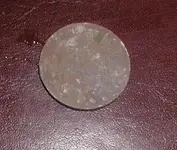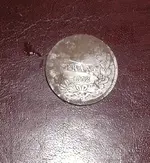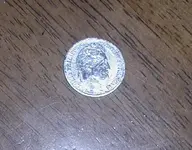If it was spanish, I wouldn't doubt at all that it was used before American colonization in the 1850's. French, though? The French weren't anywhere near California. If I had to guess, I would say a traveller or trader (maybe a trapper?) lost it while traveling through the area. Many times a lot of them had different country coins because of traveling. If only we knew for sure... Cool find and thanks for sharing.
A French Franc dating from the 1830's is a very nice find, and certainly not out of the relm of possibilities by any means in California.
Foreign currency was legal tender in the United States up to 1857, and widely accepted during daily commerce. The French 5 Franc was equal to the Spanish 8 Reales, as well as equal to our US Dollar (The US Dollar also being based on the current world currency at the founding of our country, the Spanish milled dollar or 8 Reales).
In research, I have personally read accounts where French 1 Franc coins were imported into California by ship, literally by barrels full, during the 1850's. Considering the two principal forms of silver coinage circulating there in California were the silver US quarter dollar ($0.25), and Latin American (Spanish Colonial and independent states/countries) silver 2 Reales (1/4 of an 8 Reales in value), the French 1 Franc was found to circulate at equal rate being near the same size and shape. However, those enterprising individuals taking advantage in importing these French 1 Franc pieces gained an instant 25% profit at the first exchange in California markets, as there were five coins of silver 1 Francs needed to equal a US Dollar! With the Act of Congress in 1857 abolishing acceptance of foreign silver as legal tender, the French Francs and other foreign coins soon disappeared from circulation. For an interim period, the United States mints in 1857 offered to accept all foreign coinage, even worn and devalued, at full value, in exchange for US coinage. The majority of this was paid for though, using the newly minted Flying Eagle cents, which for the first time in our history carried a metal value well below face value (the earlier Large Cents and Half Cents were originally intended to circulate carrying a metal weight almost up to 100th of a dollar, and 200th of a dollar respectively). Of course the government made a hefty profit on this exchange (even when allowing "full" value for worn-down foreign silver coinage such as Francs & Reales! The silver Francs, Reales, and other foreign coins were soon melted at the mints of San Francisco, New Orleans, and Philadelphia, and reborn as Seated Liberty coinage, as well as the new silver $0.03 pieces.
A French Franc such as we see here, would have been a common sight in daily commerce of California, for nearly a decade up to 1857. After that date, the probability of circulaltion is rare indeed. So, rather than some lone trapper, early explorer, or similar romantic thought, the facts of circulation and loss of such a coin are more in line with everyday people conducting normal trade for goods and services, in a period possibly slightly before, or more likely during, the early statehood.
 CC Hunter
CC Hunter ! At first I had no idea what it was till I just lightly wiped away some dirt and then I saw 1832 ! It turned out to be my oldest coin ever !
! At first I had no idea what it was till I just lightly wiped away some dirt and then I saw 1832 ! It turned out to be my oldest coin ever !
 It's a 1 Franc with King Louis Philippe I on it . Very cool looking coin . Could this have been used here in California before it was a state ? Any info would be great !
It's a 1 Franc with King Louis Philippe I on it . Very cool looking coin . Could this have been used here in California before it was a state ? Any info would be great ! 












